2013 BMW 640I GRAN COUPE brake sensor
[x] Cancel search: brake sensorPage 98 of 305

▷When a vehicle is approaching at a speed
much faster than your own.▷In heavy fog, rain or snowfall.▷In tight curves or on narrow lanes.
Radar sensors
The radar sensors are located under the rear
bumper.
The system may not be fully functional in the
following situations:
▷Dirty or icy bumper.▷Stickers on the bumper.
A Check Control message is displayed when the
system is not fully functional.
For US owners only
The transmitter and receiver units comply with
part 15 of the FCC/Federal Communication
Commission regulations. Operation is governed
by the following:
FCC ID:
▷NBG009014A.
Compliance statement:
This device complies with part 15 of the FCC
Rules. Operation is subject to the following two
conditions:
▷This device may not cause harmful interfer‐
ence, and▷this device must accept any interference re‐
ceived, including interference that may
cause undesired operation.Any unauthorized modifications or changes to
these devices could void the user's authority to
operate this equipment.
Brake force display
The concept▷During normal brake application, the outer
brake lamps light up.▷During heavy brake application, the inner
brake lamps light up in addition.Seite 98ControlsSafety98
Online Edition for Part no. 01 40 2 900 405 - 03 12 490
Page 106 of 305
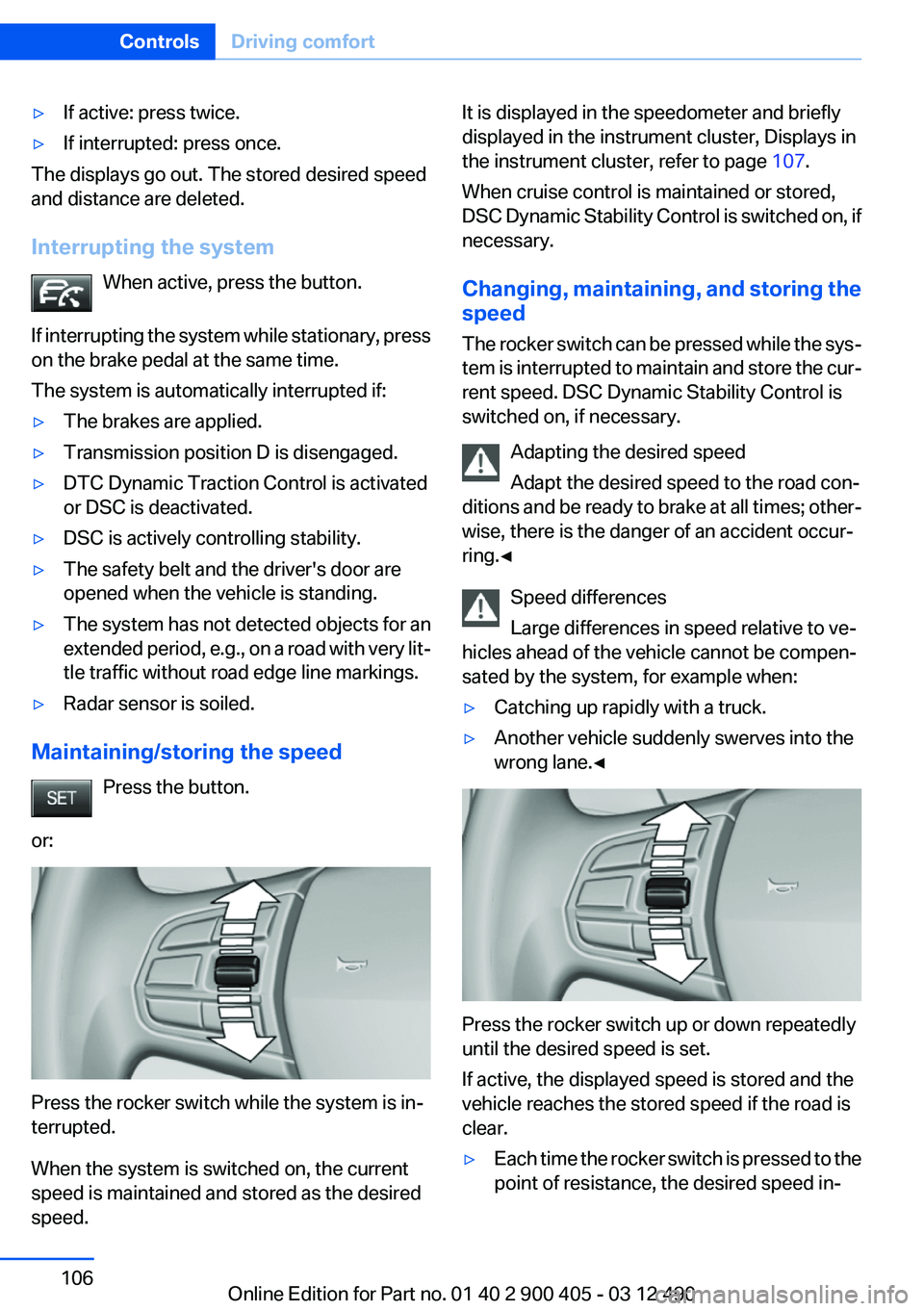
▷If active: press twice.▷If interrupted: press once.
The displays go out. The stored desired speed
and distance are deleted.
Interrupting the system When active, press the button.
If interrupting the system while stationary, press
on the brake pedal at the same time.
The system is automatically interrupted if:
▷The brakes are applied.▷Transmission position D is disengaged.▷DTC Dynamic Traction Control is activated
or DSC is deactivated.▷DSC is actively controlling stability.▷The safety belt and the driver's door are
opened when the vehicle is standing.▷The system has not detected objects for an
extended period, e.g., on a road with very lit‐
tle traffic without road edge line markings.▷Radar sensor is soiled.
Maintaining/storing the speed
Press the button.
or:
Press the rocker switch while the system is in‐
terrupted.
When the system is switched on, the current
speed is maintained and stored as the desired
speed.
It is displayed in the speedometer and briefly
displayed in the instrument cluster, Displays in
the instrument cluster, refer to page 107.
When cruise control is maintained or stored,
DSC Dynamic Stability Control is switched on, if
necessary.
Changing, maintaining, and storing the
speed
The rocker switch can be pressed while the sys‐
tem is interrupted to maintain and store the cur‐
rent speed. DSC Dynamic Stability Control is
switched on, if necessary.
Adapting the desired speed
Adapt the desired speed to the road con‐
ditions and be ready to brake at all times; other‐
wise, there is the danger of an accident occur‐
ring.◀
Speed differences
Large differences in speed relative to ve‐
hicles ahead of the vehicle cannot be compen‐
sated by the system, for example when:▷Catching up rapidly with a truck.▷Another vehicle suddenly swerves into the
wrong lane.◀
Press the rocker switch up or down repeatedly
until the desired speed is set.
If active, the displayed speed is stored and the
vehicle reaches the stored speed if the road is
clear.
▷Each time the rocker switch is pressed to the
point of resistance, the desired speed in‐Seite 106ControlsDriving comfort106
Online Edition for Part no. 01 40 2 900 405 - 03 12 490
Page 112 of 305
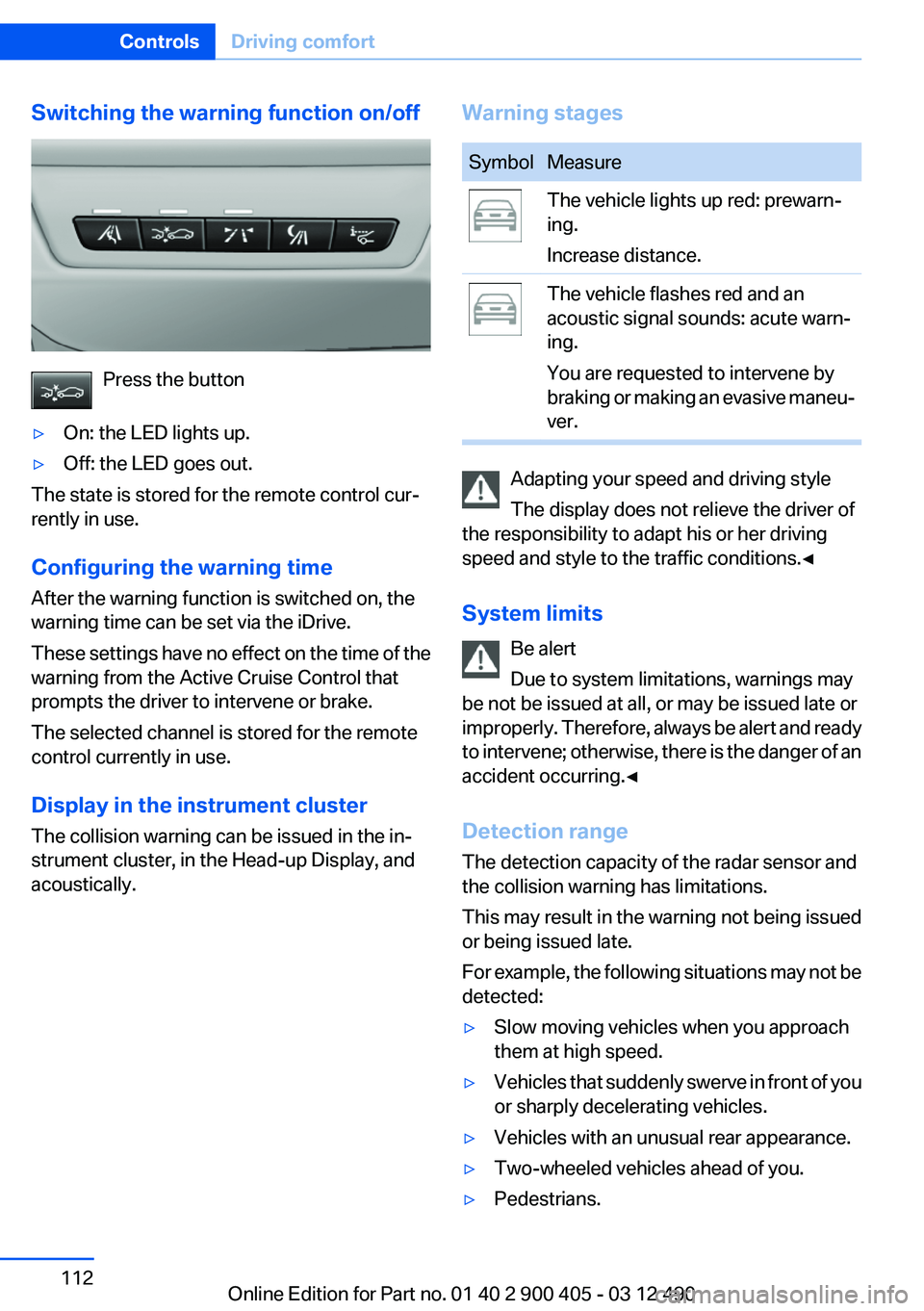
Switching the warning function on/off
Press the button
▷On: the LED lights up.▷Off: the LED goes out.
The state is stored for the remote control cur‐
rently in use.
Configuring the warning time
After the warning function is switched on, the
warning time can be set via the iDrive.
These settings have no effect on the time of the
warning from the Active Cruise Control that
prompts the driver to intervene or brake.
The selected channel is stored for the remote
control currently in use.
Display in the instrument cluster
The collision warning can be issued in the in‐
strument cluster, in the Head-up Display, and
acoustically.
Warning stagesSymbolMeasureThe vehicle lights up red: prewarn‐
ing.
Increase distance.The vehicle flashes red and an
acoustic signal sounds: acute warn‐
ing.
You are requested to intervene by
braking or making an evasive maneu‐
ver.
Adapting your speed and driving style
The display does not relieve the driver of
the responsibility to adapt his or her driving
speed and style to the traffic conditions.◀
System limits Be alert
Due to system limitations, warnings may
be not be issued at all, or may be issued late or
improperly. Therefore, always be alert and ready
to intervene; otherwise, there is the danger of an
accident occurring.◀
Detection range
The detection capacity of the radar sensor and
the collision warning has limitations.
This may result in the warning not being issued
or being issued late.
For example, the following situations may not be
detected:
▷Slow moving vehicles when you approach
them at high speed.▷Vehicles that suddenly swerve in front of you
or sharply decelerating vehicles.▷Vehicles with an unusual rear appearance.▷Two-wheeled vehicles ahead of you.▷Pedestrians.Seite 112ControlsDriving comfort112
Online Edition for Part no. 01 40 2 900 405 - 03 12 490
Page 113 of 305
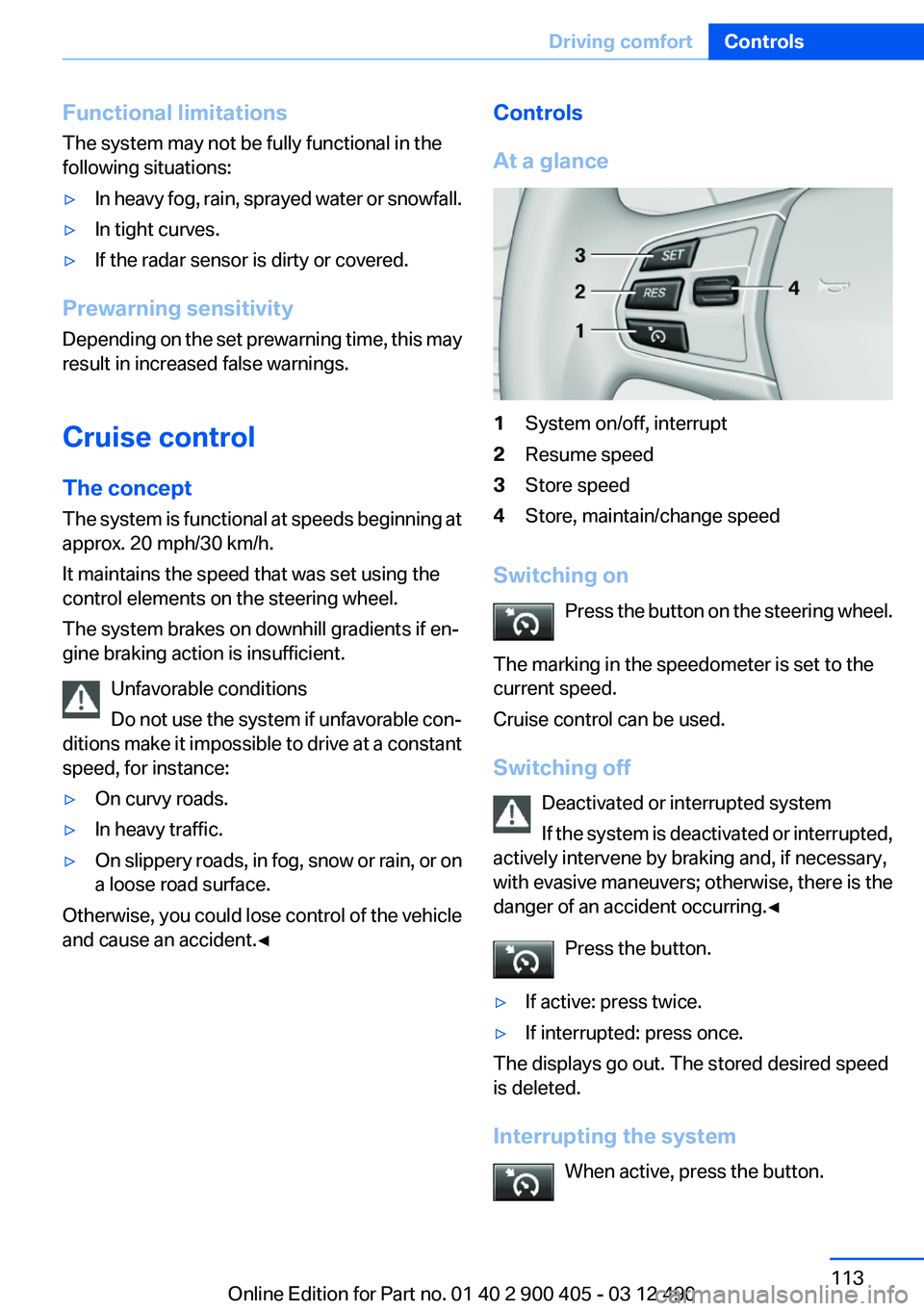
Functional limitations
The system may not be fully functional in the
following situations:▷In heavy fog, rain, sprayed water or snowfall.▷In tight curves.▷If the radar sensor is dirty or covered.
Prewarning sensitivity
Depending on the set prewarning time, this may
result in increased false warnings.
Cruise control
The concept
The system is functional at speeds beginning at
approx. 20 mph/30 km/h.
It maintains the speed that was set using the
control elements on the steering wheel.
The system brakes on downhill gradients if en‐
gine braking action is insufficient.
Unfavorable conditions
Do not use the system if unfavorable con‐
ditions make it impossible to drive at a constant
speed, for instance:
▷On curvy roads.▷In heavy traffic.▷On slippery roads, in fog, snow or rain, or on
a loose road surface.
Otherwise, you could lose control of the vehicle
and cause an accident.◀
Controls
At a glance1System on/off, interrupt2Resume speed3Store speed4Store, maintain/change speed
Switching on Press the button on the steering wheel.
The marking in the speedometer is set to the
current speed.
Cruise control can be used.
Switching off Deactivated or interrupted system
If the system is deactivated or interrupted,
actively intervene by braking and, if necessary,
with evasive maneuvers; otherwise, there is the
danger of an accident occurring.◀
Press the button.
▷If active: press twice.▷If interrupted: press once.
The displays go out. The stored desired speed
is deleted.
Interrupting the system When active, press the button.
Seite 113Driving comfortControls113
Online Edition for Part no. 01 40 2 900 405 - 03 12 490
Page 262 of 305
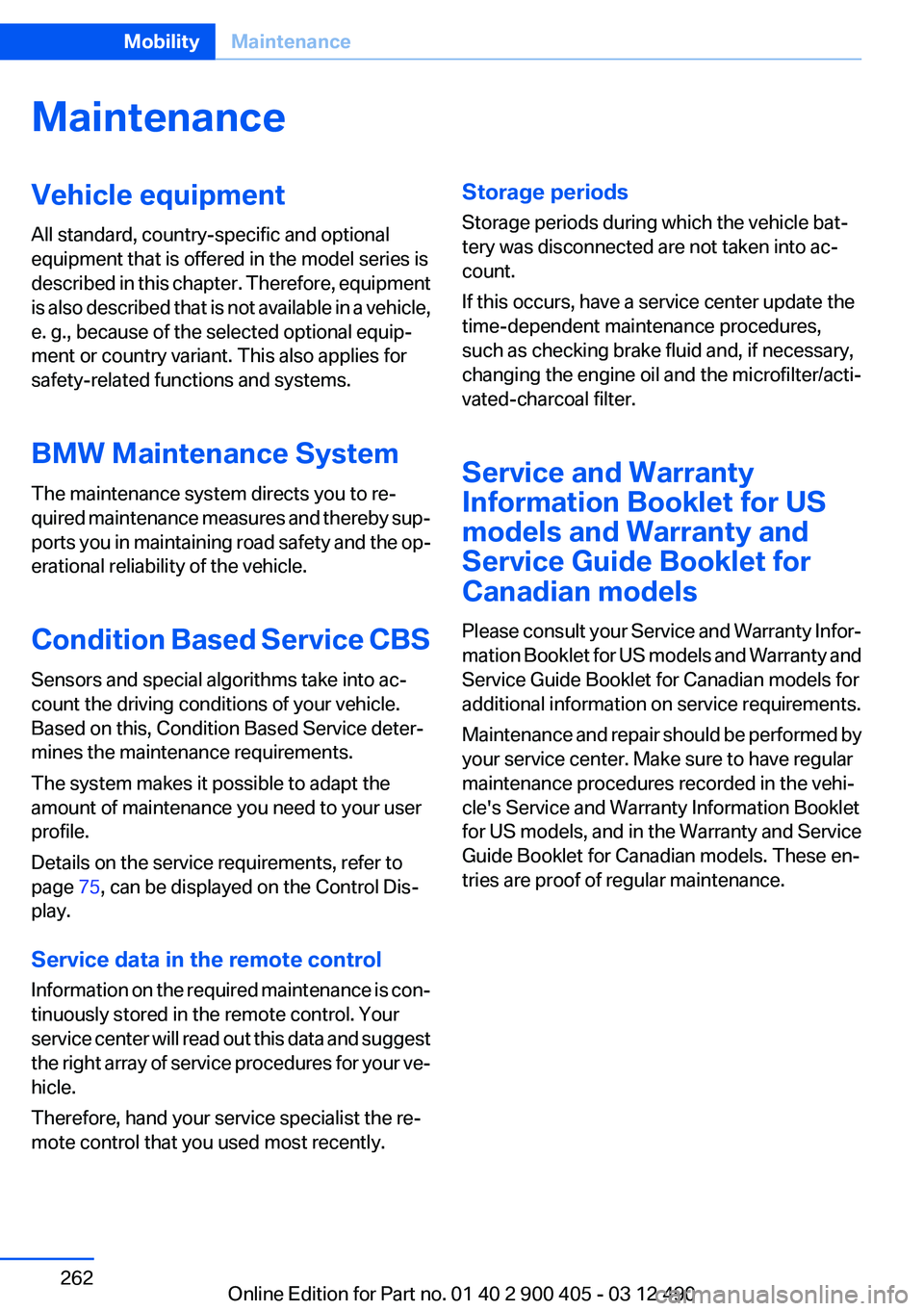
MaintenanceVehicle equipment
All standard, country-specific and optional
equipment that is offered in the model series is
described in this chapter. Therefore, equipment
is also described that is not available in a vehicle,
e. g., because of the selected optional equip‐
ment or country variant. This also applies for
safety-related functions and systems.
BMW Maintenance System
The maintenance system directs you to re‐
quired maintenance measures and thereby sup‐
ports you in maintaining road safety and the op‐
erational reliability of the vehicle.
Condition Based Service CBS
Sensors and special algorithms take into ac‐
count the driving conditions of your vehicle.
Based on this, Condition Based Service deter‐
mines the maintenance requirements.
The system makes it possible to adapt the
amount of maintenance you need to your user
profile.
Details on the service requirements, refer to
page 75, can be displayed on the Control Dis‐
play.
Service data in the remote control
Information on the required maintenance is con‐
tinuously stored in the remote control. Your
service center will read out this data and suggest
the right array of service procedures for your ve‐
hicle.
Therefore, hand your service specialist the re‐
mote control that you used most recently.Storage periods
Storage periods during which the vehicle bat‐
tery was disconnected are not taken into ac‐
count.
If this occurs, have a service center update the
time-dependent maintenance procedures,
such as checking brake fluid and, if necessary,
changing the engine oil and the microfilter/acti‐
vated-charcoal filter.
Service and Warranty
Information Booklet for US
models and Warranty and
Service Guide Booklet for
Canadian models
Please consult your Service and Warranty Infor‐
mation Booklet for US models and Warranty and
Service Guide Booklet for Canadian models for
additional information on service requirements.
Maintenance and repair should be performed by
your service center. Make sure to have regular
maintenance procedures recorded in the vehi‐
cle's Service and Warranty Information Booklet
for US models, and in the Warranty and Service
Guide Booklet for Canadian models. These en‐
tries are proof of regular maintenance.Seite 262MobilityMaintenance262
Online Edition for Part no. 01 40 2 900 405 - 03 12 490
Page 275 of 305
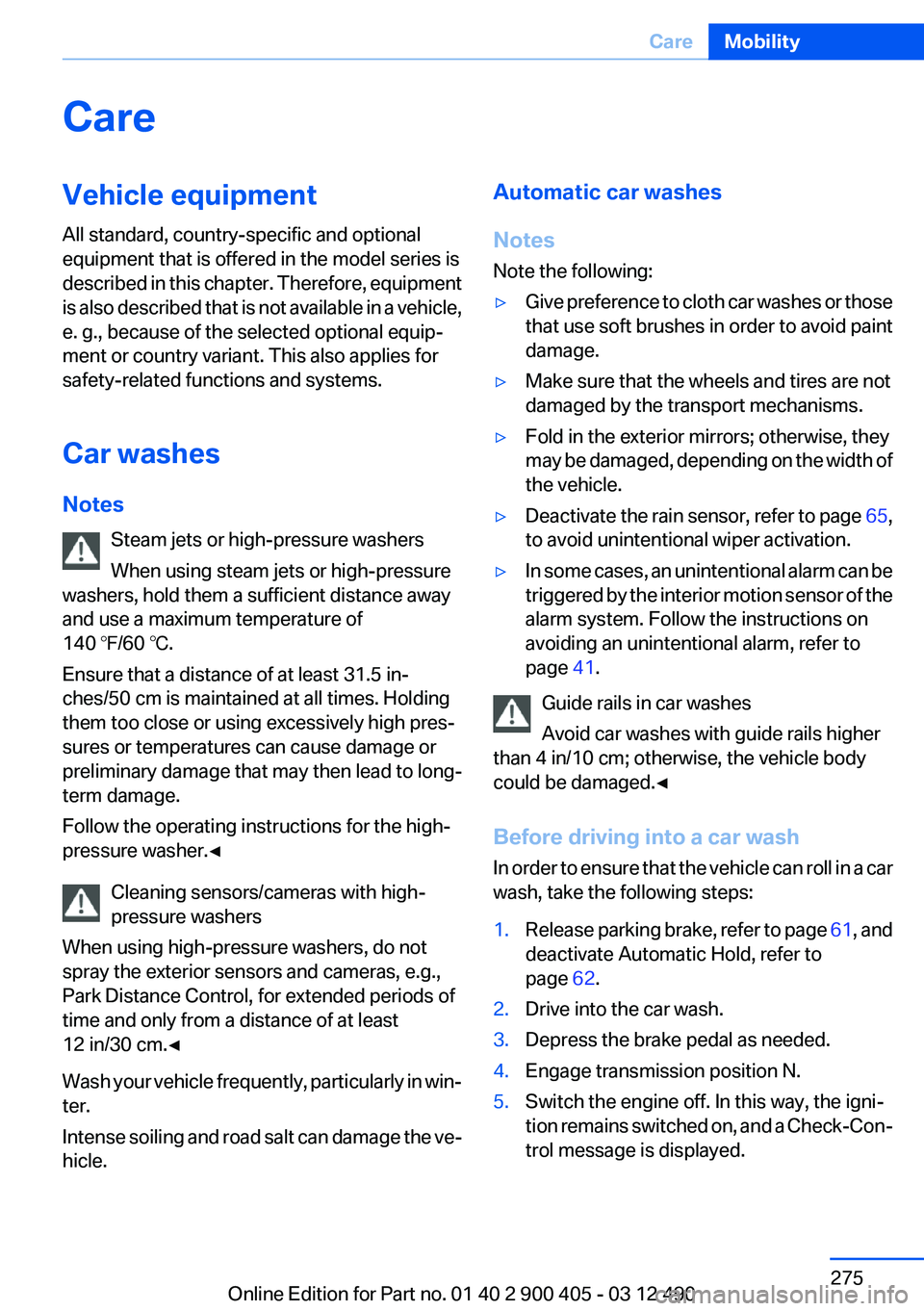
CareVehicle equipment
All standard, country-specific and optional
equipment that is offered in the model series is
described in this chapter. Therefore, equipment
is also described that is not available in a vehicle,
e. g., because of the selected optional equip‐
ment or country variant. This also applies for
safety-related functions and systems.
Car washes
Notes Steam jets or high-pressure washers
When using steam jets or high-pressure
washers, hold them a sufficient distance away
and use a maximum temperature of
140 ℉/60 ℃.
Ensure that a distance of at least 31.5 in‐
ches/50 cm is maintained at all times. Holding
them too close or using excessively high pres‐
sures or temperatures can cause damage or
preliminary damage that may then lead to long-
term damage.
Follow the operating instructions for the high-
pressure washer.◀
Cleaning sensors/cameras with high-
pressure washers
When using high-pressure washers, do not
spray the exterior sensors and cameras, e.g.,
Park Distance Control, for extended periods of
time and only from a distance of at least
12 in/30 cm.◀
Wash your vehicle frequently, particularly in win‐
ter.
Intense soiling and road salt can damage the ve‐
hicle.Automatic car washes
Notes
Note the following:▷Give preference to cloth car washes or those
that use soft brushes in order to avoid paint
damage.▷Make sure that the wheels and tires are not
damaged by the transport mechanisms.▷Fold in the exterior mirrors; otherwise, they
may be damaged, depending on the width of
the vehicle.▷Deactivate the rain sensor, refer to page 65,
to avoid unintentional wiper activation.▷In some cases, an unintentional alarm can be
triggered by the interior motion sensor of the
alarm system. Follow the instructions on
avoiding an unintentional alarm, refer to
page 41.
Guide rails in car washes
Avoid car washes with guide rails higher
than 4 in/10 cm; otherwise, the vehicle body
could be damaged.◀
Before driving into a car wash
In order to ensure that the vehicle can roll in a car
wash, take the following steps:
1.Release parking brake, refer to page 61, and
deactivate Automatic Hold, refer to
page 62.2.Drive into the car wash.3.Depress the brake pedal as needed.4.Engage transmission position N.5.Switch the engine off. In this way, the igni‐
tion remains switched on, and a Check-Con‐
trol message is displayed.Seite 275CareMobility275
Online Edition for Part no. 01 40 2 900 405 - 03 12 490
Page 300 of 305
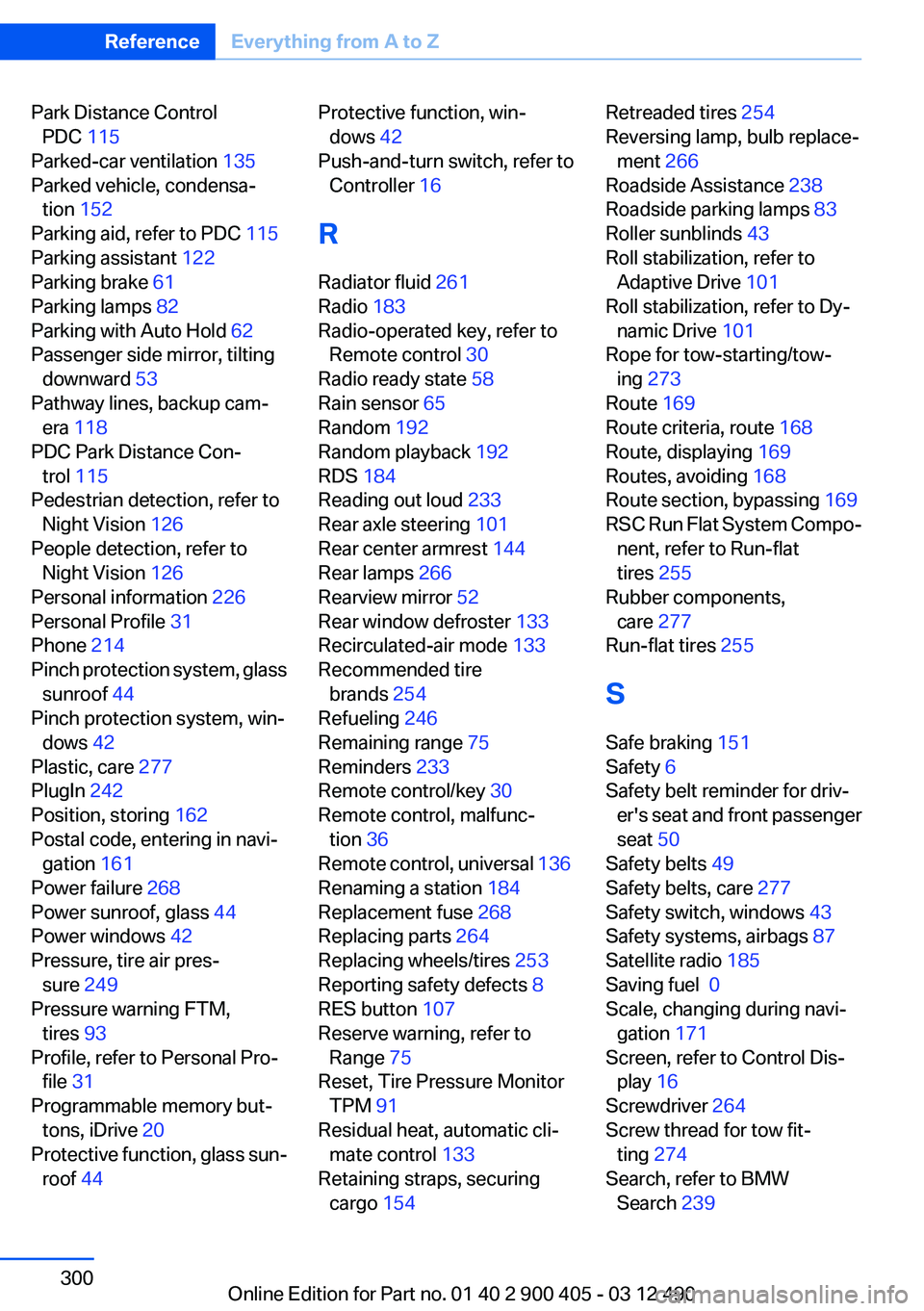
Park Distance ControlPDC 115
Parked-car ventilation 135
Parked vehicle, condensa‐ tion 152
Parking aid, refer to PDC 115
Parking assistant 122
Parking brake 61
Parking lamps 82
Parking with Auto Hold 62
Passenger side mirror, tilting downward 53
Pathway lines, backup cam‐ era 118
PDC Park Distance Con‐ trol 115
Pedestrian detection, refer to Night Vision 126
People detection, refer to Night Vision 126
Personal information 226
Personal Profile 31
Phone 214
Pinch protection system, glass sunroof 44
Pinch protection system, win‐ dows 42
Plastic, care 277
PlugIn 242
Position, storing 162
Postal code, entering in navi‐ gation 161
Power failure 268
Power sunroof, glass 44
Power windows 42
Pressure, tire air pres‐ sure 249
Pressure warning FTM, tires 93
Profile, refer to Personal Pro‐ file 31
Programmable memory but‐ tons, iDrive 20
Protective function, glass sun‐ roof 44 Protective function, win‐
dows 42
Push-and-turn switch, refer to Controller 16
R
Radiator fluid 261
Radio 183
Radio-operated key, refer to Remote control 30
Radio ready state 58
Rain sensor 65
Random 192
Random playback 192
RDS 184
Reading out loud 233
Rear axle steering 101
Rear center armrest 144
Rear lamps 266
Rearview mirror 52
Rear window defroster 133
Recirculated-air mode 133
Recommended tire brands 254
Refueling 246
Remaining range 75
Reminders 233
Remote control/key 30
Remote control, malfunc‐ tion 36
Remote control, universal 136
Renaming a station 184
Replacement fuse 268
Replacing parts 264
Replacing wheels/tires 253
Reporting safety defects 8
RES button 107
Reserve warning, refer to Range 75
Reset, Tire Pressure Monitor TPM 91
Residual heat, automatic cli‐ mate control 133
Retaining straps, securing cargo 154 Retreaded tires 254
Reversing lamp, bulb replace‐ ment 266
Roadside Assistance 238
Roadside parking lamps 83
Roller sunblinds 43
Roll stabilization, refer to Adaptive Drive 101
Roll stabilization, refer to Dy‐ namic Drive 101
Rope for tow-starting/tow‐ ing 273
Route 169
Route criteria, route 168
Route, displaying 169
Routes, avoiding 168
Route section, bypassing 169
RSC Run Flat System Compo‐ nent, refer to Run-flat
tires 255
Rubber components, care 277
Run-flat tires 255
S
Safe braking 151
Safety 6
Safety belt reminder for driv‐ er's seat and front passenger
seat 50
Safety belts 49
Safety belts, care 277
Safety switch, windows 43
Safety systems, airbags 87
Satellite radio 185
Saving fuel 0
Scale, changing during navi‐ gation 171
Screen, refer to Control Dis‐ play 16
Screwdriver 264
Screw thread for tow fit‐ ting 274
Search, refer to BMW Search 239 Seite 300ReferenceEverything from A to Z300
Online Edition for Part no. 01 40 2 900 405 - 03 12 490
Page 301 of 305
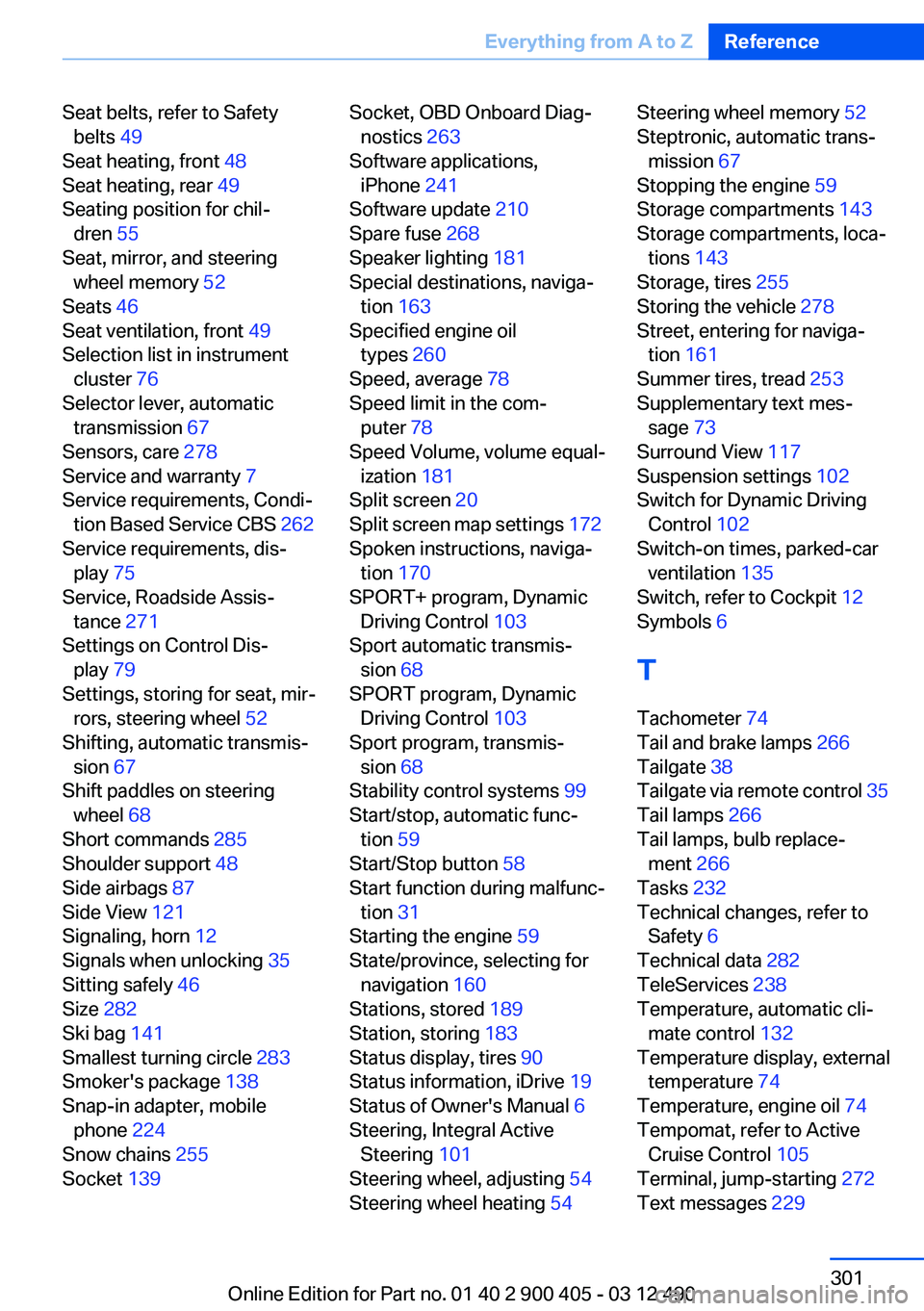
Seat belts, refer to Safetybelts 49
Seat heating, front 48
Seat heating, rear 49
Seating position for chil‐ dren 55
Seat, mirror, and steering wheel memory 52
Seats 46
Seat ventilation, front 49
Selection list in instrument cluster 76
Selector lever, automatic transmission 67
Sensors, care 278
Service and warranty 7
Service requirements, Condi‐ tion Based Service CBS 262
Service requirements, dis‐ play 75
Service, Roadside Assis‐ tance 271
Settings on Control Dis‐ play 79
Settings, storing for seat, mir‐ rors, steering wheel 52
Shifting, automatic transmis‐ sion 67
Shift paddles on steering wheel 68
Short commands 285
Shoulder support 48
Side airbags 87
Side View 121
Signaling, horn 12
Signals when unlocking 35
Sitting safely 46
Size 282
Ski bag 141
Smallest turning circle 283
Smoker's package 138
Snap-in adapter, mobile phone 224
Snow chains 255
Socket 139 Socket, OBD Onboard Diag‐
nostics 263
Software applications, iPhone 241
Software update 210
Spare fuse 268
Speaker lighting 181
Special destinations, naviga‐ tion 163
Specified engine oil types 260
Speed, average 78
Speed limit in the com‐ puter 78
Speed Volume, volume equal‐ ization 181
Split screen 20
Split screen map settings 172
Spoken instructions, naviga‐ tion 170
SPORT+ program, Dynamic Driving Control 103
Sport automatic transmis‐ sion 68
SPORT program, Dynamic Driving Control 103
Sport program, transmis‐ sion 68
Stability control systems 99
Start/stop, automatic func‐ tion 59
Start/Stop button 58
Start function during malfunc‐ tion 31
Starting the engine 59
State/province, selecting for navigation 160
Stations, stored 189
Station, storing 183
Status display, tires 90
Status information, iDrive 19
Status of Owner's Manual 6
Steering, Integral Active Steering 101
Steering wheel, adjusting 54
Steering wheel heating 54 Steering wheel memory 52
Steptronic, automatic trans‐ mission 67
Stopping the engine 59
Storage compartments 143
Storage compartments, loca‐ tions 143
Storage, tires 255
Storing the vehicle 278
Street, entering for naviga‐ tion 161
Summer tires, tread 253
Supplementary text mes‐ sage 73
Surround View 117
Suspension settings 102
Switch for Dynamic Driving Control 102
Switch-on times, parked-car ventilation 135
Switch, refer to Cockpit 12
Symbols 6
T
Tachometer 74
Tail and brake lamps 266
Tailgate 38
Tailgate via remote control 35
Tail lamps 266
Tail lamps, bulb replace‐ ment 266
Tasks 232
Technical changes, refer to Safety 6
Technical data 282
TeleServices 238
Temperature, automatic cli‐ mate control 132
Temperature display, external temperature 74
Temperature, engine oil 74
Tempomat, refer to Active Cruise Control 105
Terminal, jump-starting 272
Text messages 229 Seite 301Everything from A to ZReference301
Online Edition for Part no. 01 40 2 900 405 - 03 12 490